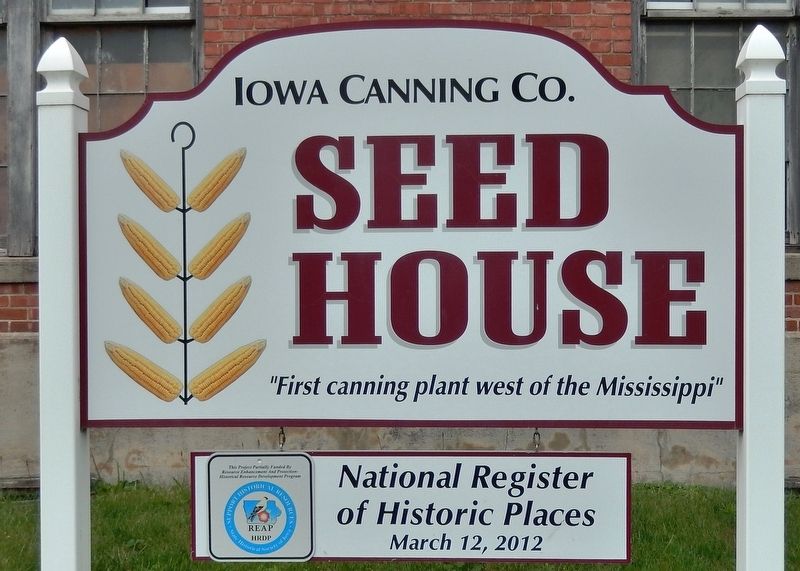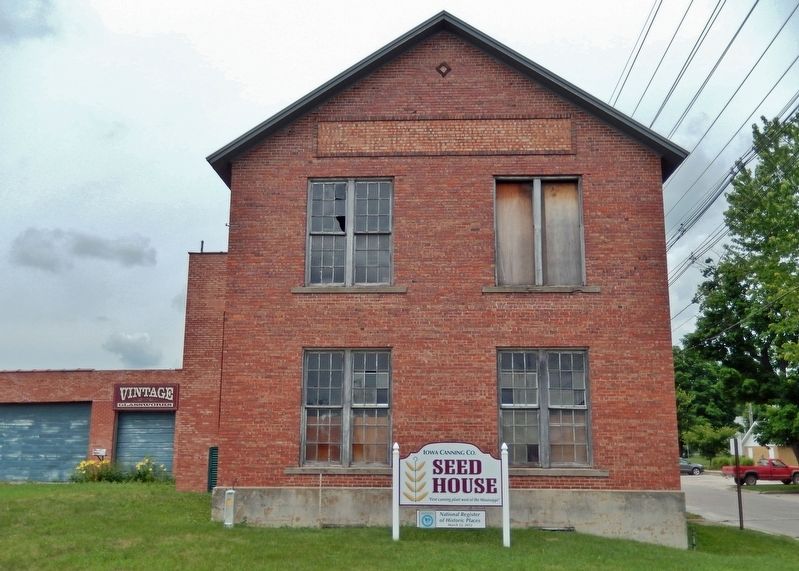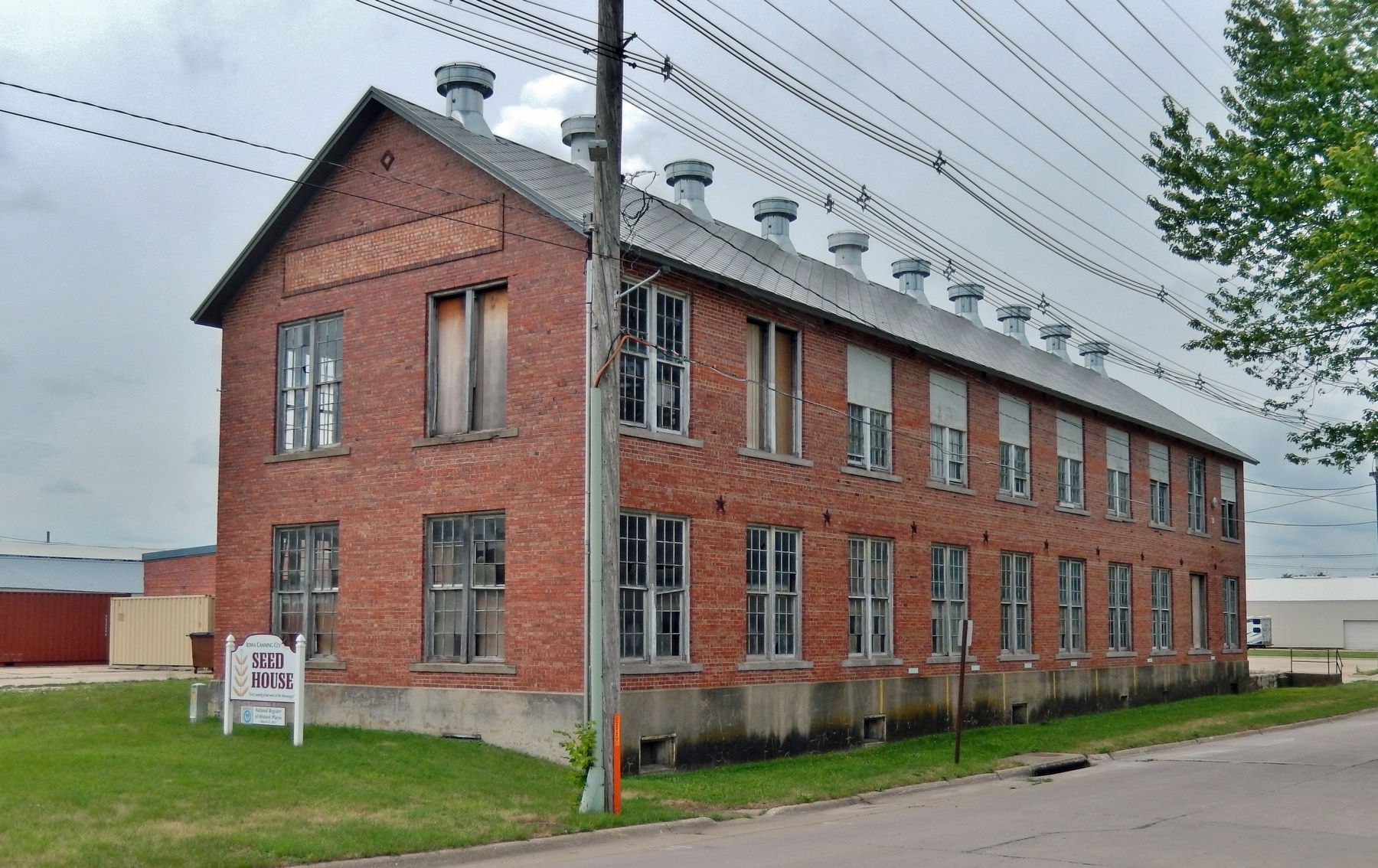Iowa Canning Co. Seed House
“First canning plant west of the Mississippi”
March 12, 2012
Topics and series. This historical marker is listed in these topic lists: Agriculture • Architecture • Industry & Commerce • Notable Buildings. In addition, it is included in the National Register of Historic Places series list. A significant historical year for this entry is 1927.
Location. 42° 10.17′ N, 92° 1.467′ W. Marker is in Vinton, Iowa, in Benton County. Marker is at the intersection of 1st Avenue (State Highway 150) and West 2nd Street, on the left when traveling north on 1st Avenue. The marker is located directly in front of the east facade of the subject building. Touch for map. Marker is at or near this postal address: 201 1st Avenue, Vinton IA 52349, United States of America. Touch for directions.
Other nearby markers. At least 8 other markers are within walking distance of this marker. Minne Estema Park (about 300 feet away, measured in a direct line); Flooding of the Cedar River (about 300 feet away); The Many Bridges Built to Cross the Cedar River (about 300 feet away); Moments in Time on the Cedar (about 300 feet away); Red Cedar River (about 300 feet away); Watson's Opera House (about 600 feet away); Benton County Courthouse (about 600 feet away); Benton County World War II Veterans Memorial (about 600 feet away). Touch for a list and map of all markers in Vinton.
Regarding Iowa Canning Co. Seed House. National Register of Historic Places #12000094.
From the National Register Nomination:
The Iowa Canning Company Seed House Building was built in ca. 1927. The first photo documenting the present building in place is a view taken in 1931 when the building appears in the background of a scene from the Vinton Sweet Corn Day parade held on September 10, 1931. The building was first used as a seed house to handle the conditioning, processing, and storing of seed used by the Iowa Canning Company for its contract farmers and company-owned farming operations. The building is significant for its association with the operation of the Iowa Canning Company, one of Iowa’s largest canning operations from the late 19th century through the mid-20th century. As the last surviving building associated with the Iowa Canning Company’s operations, the building tells the story of this important local business.The Iowa Canning Company Seed House is an example of an industrial building that uses a Gable Roof, 2-story warehouse/factory form more typical of buildings erected during the 19th century rather than a single or multi-story, flat roofed or monitor roofed warehouse/factory form from the early 20th century. The building was originally constructed with a poured concrete foundation formed up with 12-inch-wide horizontal members (pour marks are evident on interior basement
walls). The poured foundation is 16 inches thick, and the brick walls are 13 inches thick. The upper walls of the Seed House are constructed of mottled reddish brown-colored brick laid in a variation of the American bond with every seventh row laid as a header course and the other rows laid as stretcher courses. The interior walls contain a mix of common brick and clay tile brick and block typical of a late 1920s construction date.Two sets of nine iron star anchor plates/wall washers are part of the building’s internal steel post and beam system. One row is located between the first and second floors and the second at the top of the wall just under the eaves. The outer ends of the internal I-beams are embedded in the masonry walls with each I-beam connected through the wall cavity by a bolt or rod to the exterior. Here 12-inch steel star washers are held in place by a large nut. The star washers and I-beams together serve as a stabilizing system for the masonry walls.
During the 1930s, the use of hybrid seed in Iowa began to be more common though open pollinated corn seed remained the preferred choice for Iowa farmers until after World War II. It is likely that the use of this building as a seed house declined after the war as reliable, higher quality hybrid seed corn became available. The Iowa Canning Company Seed House and adjacent facilities were converted for use as
several manufacturing facilities following the end of the packing season in 1959.
Related markers. Click here for a list of markers that are related to this marker.
Also see . . . Iowa Canning Company Seed House Building (Wikipedia). Excerpt:
The earliest available Sanborn map shows the [preceding] building in 1885 and lists it as S.H. Watson Canning Company. It was known as the first corn canning operation west of the Mississippi River in the 1890s. In addition to S.H. Watson, the facility went by a variety of names throughout its history: Cedar Valley Packing Company, the Vinton Canning Company, and the Iowa Canning Company. Before World War I the operation employed 250 people at its peak, and it produced more than 3 million cans annually. Ideal Industries, who manufactured hog confinement equipment and other items, occupied the building from the mid-1980s and sold it in 2002.(Submitted on January 18, 2024, by Cosmos Mariner of Cape Canaveral, Florida.)
Credits. This page was last revised on January 18, 2024. It was originally submitted on January 16, 2024, by Cosmos Mariner of Cape Canaveral, Florida. This page has been viewed 68 times since then. Photos: 1, 2, 3. submitted on January 18, 2024, by Cosmos Mariner of Cape Canaveral, Florida.


